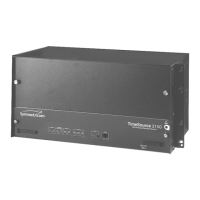097-72020-01 Revision K – December 2005 TimeSource 3100 User’s Guide 23
Chapter 1 Overview of the TimeSource 3100
Functional Description
To enable the SNTP feature, a password must be entered using the ED-EQPT TL1
command. If a user makes a fourth attempt of an incorrect password entry, the
TimeServer will lock out the user for 1 hour.
Network Time Protocol Password Activation
Use of the Simple Network Time Protocol (SNTP) feature requires activation with a
password. Activation is accomplished through receipt of a Network Time Protocol
Activation Certificate from Symmetricom. This certificate contains the unit purchase
order number, unit model number, unit activation date, unit serial number, and unit
activation key. The unit activation key is the password that enables the SNTP
feature. To activate the SNTP feature, enter the TL l command printed on the
activation certificate. Once activated, this feature will be permanently enabled. To
order the SNTP feature, contact the local Symmetricom sales representative.
BesTime Ensemble Timing Generator
Clock signals from the GPS antenna (via the IF interface), the local oscillator, the
optional external sources (E1 span lines and remote oscillators) are used as
sources by the BesTime algorithms in the BesTime Ensemble Timing Generator.
The signals are analyzed for MTIE, TDEV, and other phase and frequency
characteristics.
The BesTime Ensemble Timing Generator uses mathematical models to analyze
each clock. The ensemble algorithms use the comparisons and analyses to
generate a highly stable timing signal, which uses the best qualities of all inputs.
E1 or Analog Outputs
The BesTime Ensemble Timing Generator provides the timing for the E1 or analog
(2.048 MHz) timing signal available at the E1 OUT A and B connectors. E1 is
provided in a framed, all-ones format, which can be set to CAS, CAS4, CCS, or
CCS4 framing. 2.048 MHz is provided in accordance with G.703/10.
Eight Mixed E1/T1 Outputs (990-72020-06 Systems Only)
This option enables a user to mix any combination of E1 and T1 outputs. A user can
also use any combination of framing. For El, CCS, CAS, CCS with CRC4, and CAS
with CRC4 can be used per G.703 table 6. For T1, D4 or ESF can be used per ANSI
T1.101. In addition, there is support for analog (2.048 MHz) per G.703 table 10 and
support for synchronization status messaging (SSM) per TR-33 for El and T1. The
module mounts in the OPTIONS I/O mountings on the connector panel.

